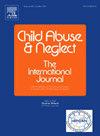计算机断层扫描辐射剂量优化用于诊断疑似身体虐待的婴儿急性肋骨骨折:一项实验动物研究。
IF 3.4
2区 心理学
Q1 FAMILY STUDIES
引用次数: 0
摘要
背景:胸部计算机断层扫描(CT)已被证明有希望改善疑似身体虐待(SPA)儿童肋骨骨折的检测。然而,对相对较高的辐射暴露的担忧使其在常规临床实践中不太可取。目的:探讨不同CT扫描参数(管电压和电流)对辐射剂量、图像质量和诊断性能(即敏感性和特异性)的影响,优化胸部CT扫描参数对婴幼儿SPA急性肋骨骨折的检测效果。方法:在创伤性肋骨骨折诱导后,5只兔子在两个中心进行了死后CT扫描,使用80和100 kV的管电压组合,逐步降低10%的管电流(mA),直到达到10 mA。两名儿科放射科医生,对扫描参数不知情,使用5分李克特量表独立评估主观图像质量,并记录急性未移位肋骨骨折的存在。读者的图像质量得分与有效剂量(ED)之间的线性回归用于确定成像参数,提供最低ED和可接受的诊断图像质量。结果:读者对图像噪声有中等程度的一致性(中心1,kappa (k) = 0.5;中心2,k = 0.45)和清晰度(中心1,k = 0.59;中心2,k = 0.55)。中心1可接受的诊断图像质量参数为80 kV/30 mA, ED为0.32 mSv,灵敏度和特异性分别为93.5%和99.4%;中心2 80 kV/40 mA, ED为0.2 mSv,灵敏度和特异性分别为84.3%和99.1%,接近SPA初始和随访骨骼调查胸片的联合ED (0.14 mSv)。结论:低剂量CT (ED接近SPA胸片的水平)可以提供足够的诊断质量的图像,以自信地诊断肋骨骨折。需要对患有SPA的儿童进行研究。本文章由计算机程序翻译,如有差异,请以英文原文为准。
Computed tomography radiation dose optimization for the diagnosis of acute rib fractures in infants investigated for suspected physical abuse: An experimental animal study
Background
Computed tomography (CT) of the chest has proven promising in improving rib fracture detection in children with suspected physical abuse (SPA). However, concerns regarding relatively higher radiation exposure make it less desirable in routine clinical practice.
Objective
To investigate the effect of varying CT scanning parameters (tube voltage and current) on radiation dose, image quality and diagnostic performance (i.e., sensitivity and specificity), and to optimize chest CT scanning parameters for the detection of acute rib fractures in infants with SPA.
Methods
Following traumatic induction of rib fractures, five rabbits underwent post-mortem CT scanning at two centres using combinations of tube voltage (80 and 100 kV) with progressive 10 % reduction in tube current (mA) until 10 mA was reached. Two pediatric radiologists, blinded to the scan parameters, independently assessed subjective image quality using a 5-point Likert scale and recorded presence of acute undisplaced rib fractures. Linear regression between the readers' scores for image quality and effective dose (ED) was used to determine the imaging parameters providing the lowest ED with acceptable diagnostic image quality.
Results
There was moderate agreement between readers for image noise (Centre 1, kappa (k) = 0.5; Centre 2, k = 0.45) and sharpness (Centre 1, k = 0.59; Centre 2, k = 0.55). The parameters with acceptable diagnostic image quality at Centre 1 were 80 kV/30 mA with an ED of 0.32 mSv and sensitivity and specificity of 93.5 % and 99.4 %, respectively, and at Centre 2 80 kV/40 mA with ED of 0.2 mSv and sensitivity and specificity of 84.3 % and 99.1 %, respectively, approaching the combined ED for initial and follow-up skeletal survey chest radiographs performed for SPA (0.14 mSv).
Conclusion
Low-dose CT (with ED approaching that of chest radiographs performed for SPA) may provide images of sufficient diagnostic quality to confidently diagnose rib fractures. Studies in children with SPA are required.
求助全文
通过发布文献求助,成功后即可免费获取论文全文。
去求助
来源期刊

Child Abuse & Neglect
Multiple-
CiteScore
7.40
自引率
10.40%
发文量
397
期刊介绍:
Official Publication of the International Society for Prevention of Child Abuse and Neglect. Child Abuse & Neglect The International Journal, provides an international, multidisciplinary forum on all aspects of child abuse and neglect, with special emphasis on prevention and treatment; the scope extends further to all those aspects of life which either favor or hinder child development. While contributions will primarily be from the fields of psychology, psychiatry, social work, medicine, nursing, law enforcement, legislature, education, and anthropology, the Journal encourages the concerned lay individual and child-oriented advocate organizations to contribute.
 求助内容:
求助内容: 应助结果提醒方式:
应助结果提醒方式:


